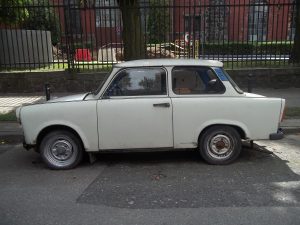58 Europe: Economic Geography II – Communism vs. Capitalism
Which is better, capitalism or communism? This is the question that started the Cold War.
As a child of the Cold War, I was taught that everything about capitalism is good, and everything about communism is bad. I’m sure that someone my age who grew up in the Soviet Union was taught the opposite. In reality, there are upsides and downsides to both economic systems. In this essay, we’ll examine those pros and cons.
The Upside of Capitalism
Europe’s rise to global dominance was largely the result of capitalism, and proof of the power of capitalism. The material wealth of the United States, West Germany, and South Korea when compared to that of the Soviet Union, East Germany, and North Korea during the Cold War is further proof. The power of capitalism is essentially based on two fundamental forces – competition and incentive.
Capitalism is an inherently competitive economic system. Businesses compete for profits. Think of Coke vs. Pepsi, Apple vs. Microsoft, or Ford vs. Chevy. Competition generally produces goods and services that are better and cheaper. Imagine that you own a company that produces a certain product, and one of your competitors finds a way to make a better and cheaper version of that same product. If that’s the case, then you’d better improve your product. If you don’t, you run the risk of losing customers and going out of business. So, you improve your product. As a result, your competitor is forced to do the same. That forces you to be improve again, which forces your competitor to improve again, and so on. Competition yields constant improvement.
Competition also exists in the workforce. Workers compete with one another for jobs, and coworkers compete with one another for promotions. It induces people to be a better job applicant – perhaps by getting additional training or education – or risk not getting a job. It induces workers to be more productive, because they want to be the person in their department that gets that promotion.
Alongside competition is incentive. Incentive is the economic force that provides owners and workers with positive and negative reinforcements that lead to innovation and hard work.
You may have heard the metaphor of the mule, the carrot, and the stick. It goes like this: If you have a stubborn mule who refuses to walk, you can do two things. The first is to dangle a carrot in front of the mule to motivate it to walk. If that doesn’t work, you smack it with the stick until it starts to walk. This metaphor is about incentive. A positive reinforcement is the carrot – the reward that motivates someone to be productive. A negative reinforcement is the stick – the punishment of someone for being unproductive.
Course grades are an example of positive and negative reinforcements. You know that if you study hard, you might get an ‘A’ – the carrot. You also know that if you don’t study hard, you might get an ‘F’ – the stick.
Positive reinforcements abound in capitalist economies. A business owner who sells a good product and treats her customers well is likely to make a bigger profit. An entrepreneur who takes risks and innovates might come up with the proverbial million-dollar idea. If you get your college degree, you’re more likely to earn a higher wage. If a worker is productive, he is more likely to get a raise and a promotion.
Of course, negative reinforcements also exist. A business owner who sells a lousy product and treats her customers poorly is likely to make a lower profit, or go out of business. An entrepreneur who never takes the risk never reaps the reward. If you drop out of college, your wages will likely be lower. If you slack off at work, you probably won’t get that raise or promotion, and you might get fired.
In short, incentive drives up productivity, and is a primary reason why capitalist economies generate so much wealth.
The Downside of Capitalism
Competition is one of the biggest reasons for capitalism’s successes, and also a primary reason for its problems. In a competition there are, by definition, winners and losers.
Look no further than the United States. Despite residing in the wealthiest country on earth, nearly 40 million Americans live in poverty – that’s greater than the total population of Canada. Consider Sam Walton, a man who lived the American dream. He was from a modest background, and became one of the wealthiest people in the world. But his innovation, Wal-Mart, destroyed tens of thousands of small, locally-owned businesses.
People get hired, and people don’t. People get a raise, and people don’t. Businesses succeed and businesses fail. For every successful restaurant, there is usually one that doesn’t last a year. And even in ideal economic times, capitalist countries rarely see unemployment fall below 4%. In the United States, that’s 7 million people, greater than the population of Indiana. In fact, many economists argue that it’s actually bad to have unemployment below 4%, because it makes labor too expensive. That’s the downside of competition – some people lose out.
There is also the problem of incentive.
The idea that capitalism rewards hard work is usually true. You probably know people who came from working-class backgrounds and who, through hard work, became quite successful. You also probably know a few people who haven’t worked particularly hard and, as a result, haven’t been particularly successful. Generally speaking, hard work leads to success, and slacking off usually doesn’t.
But that isn’t always true. You probably know people who have worked hard their whole lives, but who still struggle to make ends meet. And we all know the story of the spoiled rich kid – the one who was born on third base and thinks he hit a triple – who slacked off but still had the connections and advantages to make plenty of money. It is certainly true that the circumstances of your birth – your social class, your place of birth, your ethnicity, your gender – will create privileges and obstacles that have nothing to do with hard work or the lack of it.
Finally, there is a flaw in assuming that all wealth comes from hard work. Oftentimes, the wealthy don’t earn the majority of their wealth through salaries, but through investments. Multi-millionaires can invest a relatively small percentage of their wealth in the stock market, and earn more money from that investment in a year than many Americans earn from a lifetime of work. In a capitalist economy, the easiest way to make a lot of money is to already have a lot of money.
The Upside of Communism

The upside of communism is simple, but profound. In a communist economy, the basic necessities are guaranteed. Most citizens of communist Europe were provided with food, education, housing, health care, and employment. Homelessness, unemployment, and hunger were essentially eliminated. Universal health care was standard. College was free right up through a PhD. It is not a coincidence that successful communist revolutions happen in poor countries, not rich ones. If a large percentage of a country’s population lives in poverty, they are more likely to support communist movements.
The Downside of Communism
Some of the most enduring images of the fall of the Berlin Wall were those of East Germans driving their Trabants into West Berlin. Manufactured from 1957 to 1990, and largely unchanged over those years, the Trabant was the default car for most East Germans. It was slow, loud, ugly, and had an engine better suited to a riding lawnmower. Its body was made of a plastic resin, it belched smoke, and it had no gas gauge. In fact, it had no gas door (drivers had to mix oil and gas together and pour it in under the hood). When those Trabants rolled into West Germany, the home of legendary automakers like BMW and Mercedes, they seemed to represent everything that had gone wrong under communism.

The reason so many East Germans drove Trabants is because East Germany had only one automaker – the East German government. And this wasn’t just true of East German cars, it was true of nearly every manufactured good in nearly every country in the Soviet bloc. Every product had one manufacturer – the government. And that lack of competition is why consumer products in communist economies were so legendarily bad. There was no better, cheaper option, so the products remained lousy and expensive (not to mention scarce – East Germans would sometimes wait years for the privilege of owning a Trabant).
Communism also lacked incentive. Workers were guaranteed jobs, but they also had little room for advancement. Those who rose through ranks of communist economies usually did so because they were well-connected politically, not because they were more talented or worked harder.
Imagine a steel worker in Poland in the 1970s. Each morning he woke up knowing two things. First, he knew that if he was the model employee, and worked as hard as he possibly could, he would probably still never get a raise or a promotion. Second, he knew that if he didn’t work that hard at all, he wouldn’t be fired. Worker productivity is key to economic growth and efficiency, and workers in the communist bloc were never terribly productive. This is not because they were lazy, but simply because they lacked incentive.
Back to the course grade analogy. As was discussed, course grades are like incentive in capitalism. You have positive reinforcement – the possibility of an ‘A’ – and you have negative reinforcement – the possibility of an ‘F.’ Imagine that, on the first day of class, your professor announced that everyone in the class was going to receive a ‘C’, no matter what. You would leave class that day knowing two things. If you showed up every day, and studied harder than you’ve ever studied, you would get a ‘C’. You would also know that if you never studied at all and, in fact, never showed up again, you would still get a ‘C’. It’s unlikely that your professor would ever see you again. This is not because you’re lazy, but simply because you would have little incentive to show up.
In a sense, communism is an economic system in which everyone gets a ‘C’. Ultimately, it can eliminate the ugly aspects of capitalism – unemployment, poverty, wealth disparity, and shuttered businesses – but it eliminates all of the good things about capitalism as well.
At the end of the Cold War, most people of the Soviet bloc decided that the rewards of capitalism were worth the risks. They were ready to trade in their Trabants for a shot at a BMW.
Did You Know?
Cited and additional bibliography:
altotemi. 2016. Trabant. https://tinyurl.com/trabant16. Attribution-ShareAlike 2.0 Generic (CC BY-SA 2.0).



